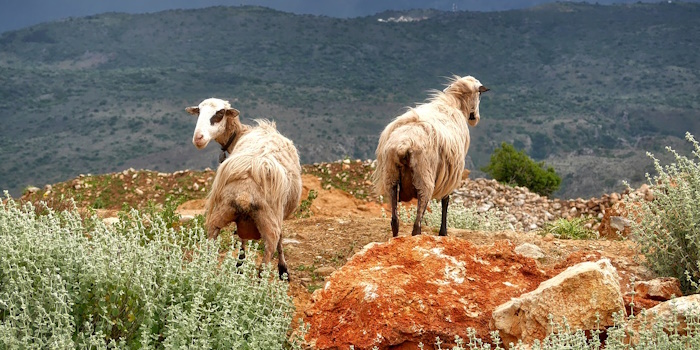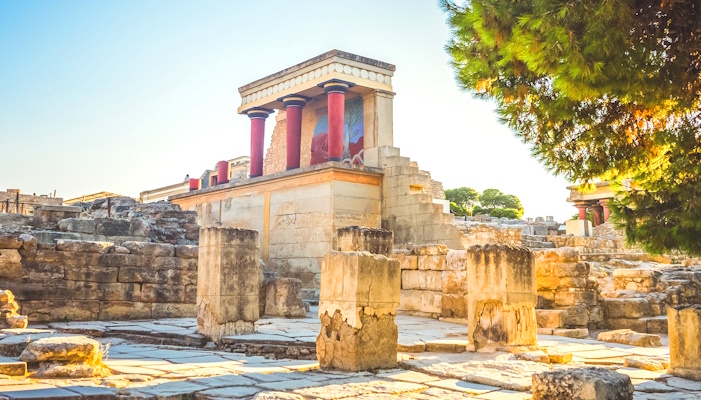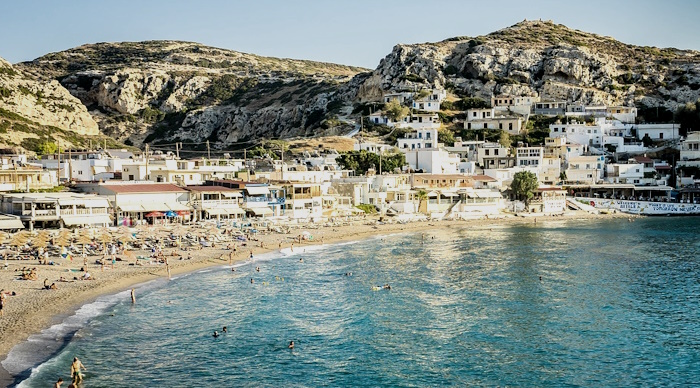Crete, by far the largest island in Greece, offers a captivating blend of history, natural beauty and modern hospitality. From its golden beaches and turquoise waters to its rugged mountains and ancient ruins, Crete is a destination that enchants visitors from the moment they arrive. Whether you’re looking for adventure, relaxation or a trip back in time, this island has something extraordinary to offer.

A rich tapestry of history
Crete is often considered the cradle of European civilisation, as the island is associated with the Minoan culture, one of the world’s earliest civilisations. A visit to the Palace of Knossos, located near Heraklion, offers a fascinating insight into this ancient world. This archaeological site, with its frescoes, magnificent halls and intricate layout, tells the story of the once-thriving Minoan civilisation.
>>> Tickets and guided tours for the Palace of Knossos should be purchased in advance on the website Getyourguide: >>> Link to the booking page

Heraklion, the capital of Crete, is also home to the Heraklion Archaeological Museum, where visitors can admire artifacts from the island’s rich past, including pottery, jewelry, and the enigmatic Phaistos Disc. In addition to the Minoan heritage, Crete also has Venetian fortresses, Byzantine monasteries, and Ottoman mosques, reflecting the island’s complex history of conquests and cultural exchanges.
Beaches that rival paradise
Crete is famous for its stunning coastline, which offers some of the most beautiful beaches in the Mediterranean. Elafonissi Beach, on the west side of the island, is known for its pink sand and shallow lagoons that create a dreamy backdrop. Further north, Balos Lagoon, accessible by boat or hiking trail, boasts crystal-clear waters and unspoiled natural beauty.
Our articles about Crete |
|
| City of Heraklion | City of Chania |
| City of Rethymno | Island of Spinalonga |
| Samaria Gorge | Excavation of Knossos |

To the south, Preveli Beach, located at the mouth of a palm-fringed river, offers a tranquil escape amidst lush green scenery. Each beach in Crete has its own charm, whether you prefer lively resorts or secluded coves.
Exploring Crete’s natural wonders
Beyond the beaches, Crete’s diverse landscapes invite exploration. The Samaria Gorge, one of the longest gorges in Europe, is a hiker’s paradise, offering dramatic scenery and the chance to spot rare wildlife. The trail winds through towering cliffs, forests and villages, ending on the shores of the Libyan Sea.
For a different perspective, the White Mountains (Lefka Ori) provide an exciting backdrop for hiking and exploring traditional mountain villages. In contrast, the island’s fertile plains and olive groves underline Crete’s agricultural roots and produce some of the finest olive oil in the world.
Lively towns and local flavour
Crete’s towns and villages exude charm and character, and each has its own story to tell. Chania, with its Venetian harbour, narrow streets and waterfront cafes, is a favourite with visitors. The town’s Old Market and Maritime Museum offer insight into the town’s life and history. Rethymno, known for its Renaissance architecture, invites you to take a leisurely stroll through the Old Town, whose picturesque alleyways lead to hidden treasures.
For an authentic experience, head to the villages of Crete, where time seems to stand still. Enjoy the warm welcome, traditional cuisine and cultural festivals celebrating Cretan music, dance and heritage.
The flavours of Crete
Cretan cuisine is a highlight of any visit, relying on fresh, local ingredients and simple yet delicious preparations. From hearty dishes like dakos (a barley rusk with tomatoes, feta and olive oil) and kalitsounia (cheese pastries) to succulent lamb dishes and freshly caught seafood, the island’s culinary offerings are unforgettable. Accompany your meal with a glass of raki, the local spirit, and savour the essence of Crete.
A destination for every traveller
Whether you’re interested in history, nature or the beach, Crete has something for every taste. The vibrant cities, stunning scenery and warm hospitality make Crete a destination that will stay with you long after your visit.

Crete’s enchanting blend of ancient wonders, natural beauty and modern comforts invites exploration and discovery at every turn. Plan your trip to this Mediterranean paradise and discover the magic of Greece’s largest island.
How big is Crete?
Crete is the largest island in Greece and the fifth largest island in the Mediterranean. It has an area of 8,336 km². The island is about 260 km long and about 60 km wide at its widest point. At its narrowest point (at Ierapetra) the width is only 12 km. The coastline of Crete stretches for about 1,046 km.
How to get to Crete?
1. Flight to Crete
Airports in Crete: There are two main airports:
Heraklion (HER) – The larger airport in the east of the island.
Chania (CHQ) – In the west of the island.
Direct flights: Flights from many European cities and large Greek cities (e.g. Athens, Thessaloniki) land in Heraklion or Chania during the season.
2. Ferry to Crete
From mainland Greece: Ferries run regularly from Piraeus (Athens) to Heraklion, Chania or less frequently to Agios Nikolaos and Rethymno on Crete.
Ferry time: 6-9 hours, depending on the destination port.
➔ To book ferries within Greece, we recommend the reputable website Ferryscanner.com
Summary:
Flights to Heraklion or Chania.
Ferries from Piraeus (Athens) to Crete.
Top 10 Crete attractions
Palace of Knossos
Immerse yourself in the heart of ancient Minoan civilization at the Palace of Knossos near Heraklion. This archaeological marvel, with its labyrinthine layout and colorful frescoes, is a must-see for history buffs.
>>> Tickets and guided tours for the Palace of Knossos should be purchased in advance on the website Getyourguide: >>> Link to the booking page
Elafonissi Beach
Famous for its pink sand and turquoise water, Elafonissi Beach is one of the most beautiful stretches of coastline in Crete. With its shallow lagoons, it is suitable for families and nature lovers alike.
Samaria Gorge